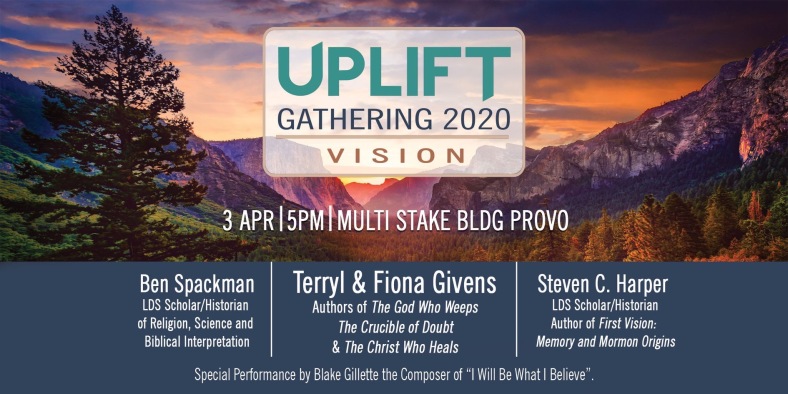
First, I’ll be speaking in Provo April 3, along with Terryl and Fiona Givens, Steven Harper, and likely some others yet to be announced. It’s free to attend, but space is limited, so register here. Continue reading
Page 21 of 40

Mormon History Association Conference 2020: Scripture, Science, Interpretation, and Fundamentalism
Notices are going out for the MHA Conference this year, to be held in Rochester NY, June 4-7. Now rescheduled for Park City, June 10-12, 2021! The schedule is not up yet, but a panel I organized has been accepted, entitled “Developing LDS Exegesis, Hermeneutics, and Epistemology from 1876-1980: Trends and Influences.” Continue reading

Come Follow Me: 1 Nephi 8-12, 15
The new manual follows a more logical division than the old, which treated 1 Nephi 8-12 and 15 as one unit, and 1Ne 13-14 as another. Nephi’s vision and then explanation runs from chapters 11-15. However, lacking time for a full rewrite, I’m putting up my two posts separately, which follow the old division. Continue reading

The 1950s: A Fundamentalist Shift
Several scholars have identified a LDS shift in the mid-20th-century towards a kind of fundamentalism. In 1980, for example, Leonard Arrington reflected in his journal on the emergence
at BYU in the 1950s…. particularly in the College of Religion [of] A sort of Mormon Fundamentalism like Protestant Fundamentalism [which] Emphasizes Biblical literalism, rejects the Higher Criticism [in biblical studies, and] the law of evolution… Continue reading

Come Follow Me: Book of Mormon Intro and Tidbits
This is a grab-bag of sorts; I’ve been sick for a few days, without full dedicated brainpower to revise/expand. Still, there’s a lot of good stuff here, food for thought.
Revelation 22, Curses, and Copy Protection

A medieval scribe. Jean le Tavernier, Public Domain
I first wrote this over 15 years ago, reposted it somewhere else, and both locations have now disappeared from the online ether. So, given that we’re studying Revelation right now, I thought I’d repost it, slightly edited but uncorrected or updated, and complete with my younger, brasher style.
What’s the best LDS response to the idea that Revelation 22:18-19 closes the canon? Continue reading
Come Follow Me: Revelation 1-2, 12
 The final book! We’ve almost made it through! The end is nigh!
The final book! We’ve almost made it through! The end is nigh!
First, a note on names. This is the book of Revelation (singular) not the book of RevelationS (plural.) It’s a really common mistake in Hollywood and elsewhere, like the “books of the Bible” tie I have, above The title Revelation comes from Rev 1:1, with that ambiguous “of” preposition. “The revelation of Jesus” can mean “a revelation that is about Jesus,” “a revelation from Jesus,” or “the revelation belonging to Jesus.” Continue reading
Come Follow Me: 1-3 John
1 John opens reminiscent of both the Gospel of John (thematically) and Luke/Acts (in contrast). That is, the vocabulary and ideas resemble John (the Word of life made visible, eternal life, light/darkness, etc). But the point-of-view contrasts Luke. Whereas Luke says he had to investigate and talk to witness, because he wasn’t a firsthand eyewitness himself, 1Jo 1:1 and 1Jo 1:3 strongly imply the opposite for the author (authors?) of 1 John. Note the plural “we” there, present from the first verses onwards. Is this a rhetorical “we” or a real “we”? Continue reading
Come Follow Me: 1-2 Peter, Jude
These three epistles are usually grouped with James and the three epistles of John, together called the Catholic Epistles. Greek katholikos means “universal”, and so they are sometimes called the General Epistles, since they’re written universally, to everyone, in general. Once again, there’s not really an overarching theme, so we’re going to play thematic wack-a-mole. Find something significant you like and expand on it. Continue reading

Come Follow Me: James
I assume James gets his own Gospel Doctrine lesson because… Joseph Smith and James 1:5? Not sure, really. But James is “the most socially conscious writing in the New Testament” (Brown, Introduction to the New Testament, 725), so it has that going for it.
Like Timothy and Titus, this epistle lacks a Big Picture woven throughout. Like Timothy and Titus, it contains very practical advice. Like Timothy and Titus, it doesn’t get a lot of attention. Continue reading
Recent Comments